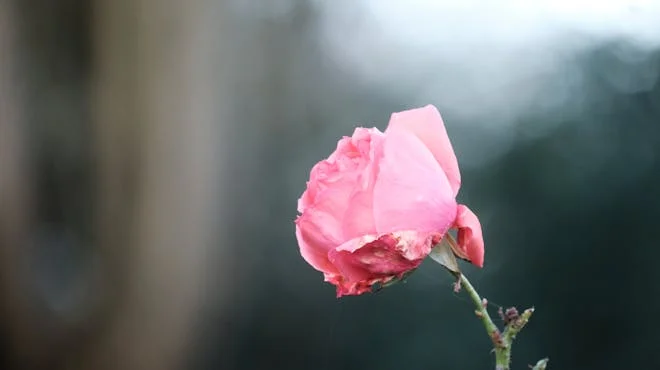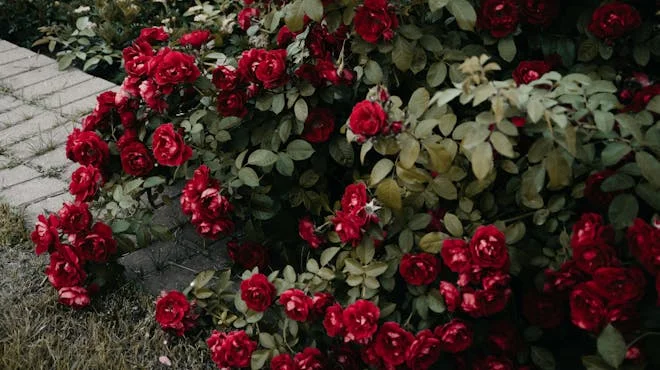
An Analysis
Welcome to our blog, where we explore the timeless beauty of literature that resonate with readers around the world.
Today, we explore the meaning of “The Rose That Grew from Concrete” by Tupac Shakur. Join us as we unveil the layers of symbolism, explore its rich imagery, and uncover the profound themes of this iconic poem. Through our analysis, we aim to provide insight into the emotions conveyed, the poet’s intention, the target audience, and the perspective from which the poem is presented. So, sit back, relax, and let’s explore the transformative power of poetry together.
The Rose That Grew From Concrete by Tupac Shakur "Did you hear about the rose that grew from a crack in the concrete? Proving nature's law is wrong it learned to walk with out having feet. Funny it seems, but by keeping its dreams, it learned to breathe fresh air. Long live the rose that grew from concrete when no one else ever cared."
Content
- The subject and context of “The Rose That Grew from Concrete” by Tupac Shakur
- Theme of “The Rose That Grew from Concrete” by Tupac Shakur
- Line by line analysis of “The Rose That Grew from Concrete” by Tupac Shakur
- Q and A
- What is the form and structure of the poem “The Rose That Grew from Concrete” by Tupac Shakur?
- Explain about the tone or mood of the poem “The Rose That Grew from Concrete” by Tupac Shakur
- Mention the literature devices used in “The Rose That Grew from Concrete” by Tupac Shakur
- What influenced the poet to write this poem?
- What is the form and structure of the poem “The Rose That Grew from Concrete” by Tupac Shakur?
- More about the author Tupac Shakur (2Pac)
The subject and context of “The Rose That Grew from Concrete” by Tupac Shakur
“The Rose That Grew from Concrete” revolves around the theme of resilience and the triumph of the human spirit over adversity. It explores the idea of finding beauty and strength in unlikely circumstances, symbolized by a rose growing from the harsh conditions of concrete.
The primary focus of the poem is the rose that emerges from the concrete, representing hope and resilience. Additionally, the poet, Tupac Shakur, infuses personal reflections and societal observations into the verses, adding depth and authenticity to the narrative.
Context of the Poem
The poem is set against the backdrop of urban societal struggles, reflecting the harsh realities faced by marginalized communities. It serves as a metaphorical commentary on the resilience of individuals who persevere and flourish despite challenging environments.
Author and Influences
“The Rose That Grew from Concrete” was penned by Tupac Shakur, a renowned hip-hop artist and poet. Influenced by his own experiences growing up in inner-city neighborhoods and witnessing societal injustices, Shakur aimed to shed light on these social struggles and the resilience they exhibit.
Persona (Narrator) and Narrative Type
The persona in the poem is not directly expressed and is possible to be Shakur’s own voice and perspective. The narrative is predominantly in the third person, allowing for a broader exploration of themes and characters while maintaining a sense of intimacy and authenticity.
Setting/ Set of the poem
The poem is set within an urban landscape characterized by concrete jungles and societal decay. This setting serves as a stark contrast to the delicate beauty of the rose, highlighting the resilience and tenacity required to thrive in challenging environments.
Theme of “The Rose That Grew from Concrete” by Tupac Shakur
Resilience: At its core, the poem celebrates the resilience of the human spirit. Through the metaphor of a rose growing from concrete, Shakur illustrates the capacity for beauty and strength to emerge from the harshest of circumstances.
Hope: Throughout the poem, there is a sense of hopefulness in the midst of challenging environments. Despite the challenges faced by the rose, it persists in its quest for growth and beauty.
Defiance: Shakur’s poem also explores the idea of defying societal norms and expectations. The rose’s very existence challenges the notion that certain environments are inhospitable to growth and beauty. Thus, by thriving in the face of adversity, the rose serves as a symbol of defiance against the status quo.
Beauty in Unlikely Places: One of the central themes of the poem is the idea that beauty can be found in the most unlikely of places. The image of a rose growing from concrete is as such. Therefore, this theme encourages readers to look beyond surface appearances and recognize the beauty and potential that lies within every individual.
Solitude and Recognition: Another recurring idea in the poem is the notion of solitude and the lack of recognition for one’s achievements. Despite its remarkable journey, the rose grows unnoticed and uncelebrated by others. Therefore, this theme underscores the idea that resilience often goes unseen and unacknowledged.

Line by line analysis of “The Rose That Grew from Concrete” by Tupac Shakur
“Did you hear about the rose that grew
from a crack in the concrete?”
The opening line immediately captures the reader’s attention with a rhetorical question, inviting them to engage with the central metaphor of the poem. By using the word “hear,” the poet suggests an oral tradition, creating a sense of intimacy.
Here, Shakur employs vivid imagery to describe the unlikely scenario of a rose emerging from a crack in concrete. Furthermore, the rose acts as a powerful metaphor for resilience and beauty flourishing in harsh and unlikely circumstances. Moreover, the juxtaposition of the delicate rose against the harsh concrete underscores the remarkable nature of its existence.
“Proving nature’s law is wrong it
learned to walk without having feet.”
In this line, the poet introduces the theme of defying societal norms and expectations. By suggesting that the rose’s existence challenges “nature’s law,” Shakur highlights the nature of human capacity to overcome harsh obstacles. The poet also uses enjambment to maintain the flow of the poem, adding to the unstoppable sense the rose brings out.
This idea of walking without feet employs metaphor to illustrate the rose’s adaptability despite the physical impossibility. As such, Shakur emphasizes the rose’s ability to flourish despite lacking conventional means of mobility. While imagery of “walking without having feet” evokes a sense of determination, the term “learn” suggests commitment and will power.
“Funny it seems, but by keeping its dreams,”
Here, the poet employs irony to underscore the absurdity of the situation. While celebrating the rose’s determination to pursue its dreams, the poet gently mocks at the general social norms with a “but”. Despite the seemingly impossible odds, the rose persists in its quest for growth and beauty. The use of personification imbues the rose with human-like qualities, such as having dreams. Additionally, the term “keeping its dreams” infers holding on and survival against the odds.
“it learned to breathe fresh air.”
In this line, Shakur employs personification to depict the rose’s capacity for growth. The poet uses repetition in “learn(ing)” to “to walk” and “to breath”, emphasizing the unshakable determination one should possess in life. By suggesting that the rose “learned” to breathe, the poet emphasizes its adaptability and ability to thrive in adverse conditions. Furthermore, “breathing fresh air” creates an imagery of a blooming tiny rose, peeping through a crack in the concrete. This evokes a sense of liberation and renewal, as suggested by the word “fresh”.
Ironically, the general norm in biology is that plants use carbon dioxide for breathing but not the oxygen. However, the term “fresh air” suggests otherwise. It is possible that the poet wanted to imply that by “learning”, one can transform the general norm and purpose of existence.
“Long live the rose that grew from concrete”
This line serves as a powerful declaration of the rose’s triumph over adversity. Additionally, it can be interpreted as a cheer or exclamation, celebrating the endurance and resilience of the rose despite the odds. This cheer can be regarded as a poet’s way of siding with the segregated societies in urban settings.
“when no one else ever cared.”
This final line emphasizes the solitary journey of the rose, highlighting the lack of recognition or support it receives from others. This adds to the poem’s message that despite the lack of external validation, the rose persists in its quest for growth and beauty.

Q and A
What is the form and structure of the poem “The Rose That Grew from Concrete” by Tupac Shakur?
The poem “The Rose That Grew from Concrete” adopts a free verse structure, devoid of traditional rhyme schemes and meter. It consists of lines varying in length and structure, contributing to the poem’s fluidity.
Additionally, the lines range from short, concise lines to longer, more expansive verses, allowing for a dynamic exploration. The varying lengths of the stanzas create a sense of rhythm and movement, mirroring the flow of life itself.
Pauses and line breaks
Within the poem, there are pauses and line breaks strategically placed to emphasize certain ideas or images. Thus, it readers to pause and reflect on the significance of each line. These pauses serve as moments of contemplation, inviting readers to dig deeper into the poem’s themes and emotions.
Punctuations
In terms of punctuation, Tupac Shakur employs a minimalist approach, with sparse punctuation used to guide the flow of the poem. This lack of punctuation lends a sense of rawness to the verses, allowing for a more intimate connection between the reader and the text.
Rhyme scheme and rhythm
While the poem does not adhere to a consistent rhyme scheme, occasional internal rhymes and assonance can be found throughout. These add a lyrical quality to the verses. Furthermore, they serve to enhance the overall musicality of the poem.
The poet’s decision to forego strict rhyme and meter reflects the organic nature of the subject matter. By embracing a free verse structure, Shakur demonstrates a commitment to raw expression and emotional honesty.
Explain about the tone or mood of the poem “The Rose That Grew from Concrete” by Tupac Shakur
The tone of “The Rose That Grew from Concrete” by Tupac Shakur is one of admiration and optimism. Shakur’s admiration is palpable throughout the poem, as he marvels at the rose’s strengths. Moreover, the tone is celebratory, as Shakur exalts the rose as a symbol of hope.
Additionally, by depicting the rose’s emergence from concrete, Shakur defies the idea that certain environments are inhospitable to growth and beauty. Therefore, there is also a sense of defiance in the poem’s tone,
Mention the literature devices used in “The Rose That Grew from Concrete” by Tupac Shakur
Metaphor: The central metaphor of the poem is the rose growing from concrete.
Personification: Shakur personifies nature, suggesting that it “learned to walk without having feet” and “learned to breathe fresh air,” imbuing the rose with human-like qualities and agency.
Imagery: The poet uses vivid imagery to describe the unlikely scenario of a rose emerging from a crack in concrete, evoking powerful visual and sensory images.
Repetition: Phrases like “learned to” and “concrete” are repeated throughout the poem, emphasizing the significance of the rose’s endurance.
Irony: Shakur employs irony when he describes the rose’s ability to “breathe fresh air” and “walk without having feet”.
Juxtaposition: The poet juxtaposes the delicate beauty of the rose with the harshness of its surroundings, creating a contrast.
Enjambment: The poet employs enjambment, or the continuation of a sentence without a pause beyond the end of a line, to create a sense of flow and momentum in the poem.
Symbolism: The rose serves as a symbol of hope, resilience, and beauty, representing the capacity for growth.
What influenced the poet to write this poem?
“The Rose That Grew from Concrete” by Tupac Shakur is deeply influenced by the poet’s own life experiences. Growing up in impoverished neighborhoods and facing societal injustices firsthand, Shakur was intimately familiar with the struggles and challenges faced by marginalized communities.
Additionally, Shakur’s background as a hip-hop artist and social activist undoubtedly influenced the style and themes of the poem. Known for his outspoken advocacy for social justice, Shakur infused “The Rose That Grew from Concrete” with his signature blend of raw emotion and social commentary.
More about the author Tupac Shakur (2Pac)
Tupac Shakur, widely known by his stage name 2Pac, was a multifaceted artist. Additionally, his impact extended far beyond the realm of music. Born on June 16, 1971, in East Harlem, New York City, Tupac experienced a tumultuous upbringing marked by poverty, violence, and instability. Not surprisingly, these early experiences deeply influenced his artistry and worldview, shaping his unique style.
As a rapper, Tupac gained fame for his thought-provoking lyrics and fearless exploration of social issues such as racism, poverty, and police brutality. As such, his music resonated with audiences from diverse backgrounds, earning him widespread acclaim as one of the most influential figures in hip-hop history.
Check Tupac’s music as a rapper and more by following this link 2Pac – Dear Mama (youtube.com)
Beyond his music, Tupac was also a prolific poet and actor, known for his roles in films such as “Juice” and “Poetic Justice.” His poetry, much like his music, reflected his keen insight into the human condition and his unwavering commitment to social justice. In works such as “The Rose That Grew from Concrete,” Tupac showcased his talent for blending vivid imagery with profound themes, inviting readers to contemplate the complexities of life and the resilience of the human spirit.
Despite his untimely death at the age of 25 in 1996, Tupac’s legacy endures, transcending generations and inspiring countless artists and activists around the world. His influence can be felt not only in music but also in literature, film, and social justice movements.
For more of our Nature poems, please follow Nature – PoemRead
RELATED POSTS
View all



